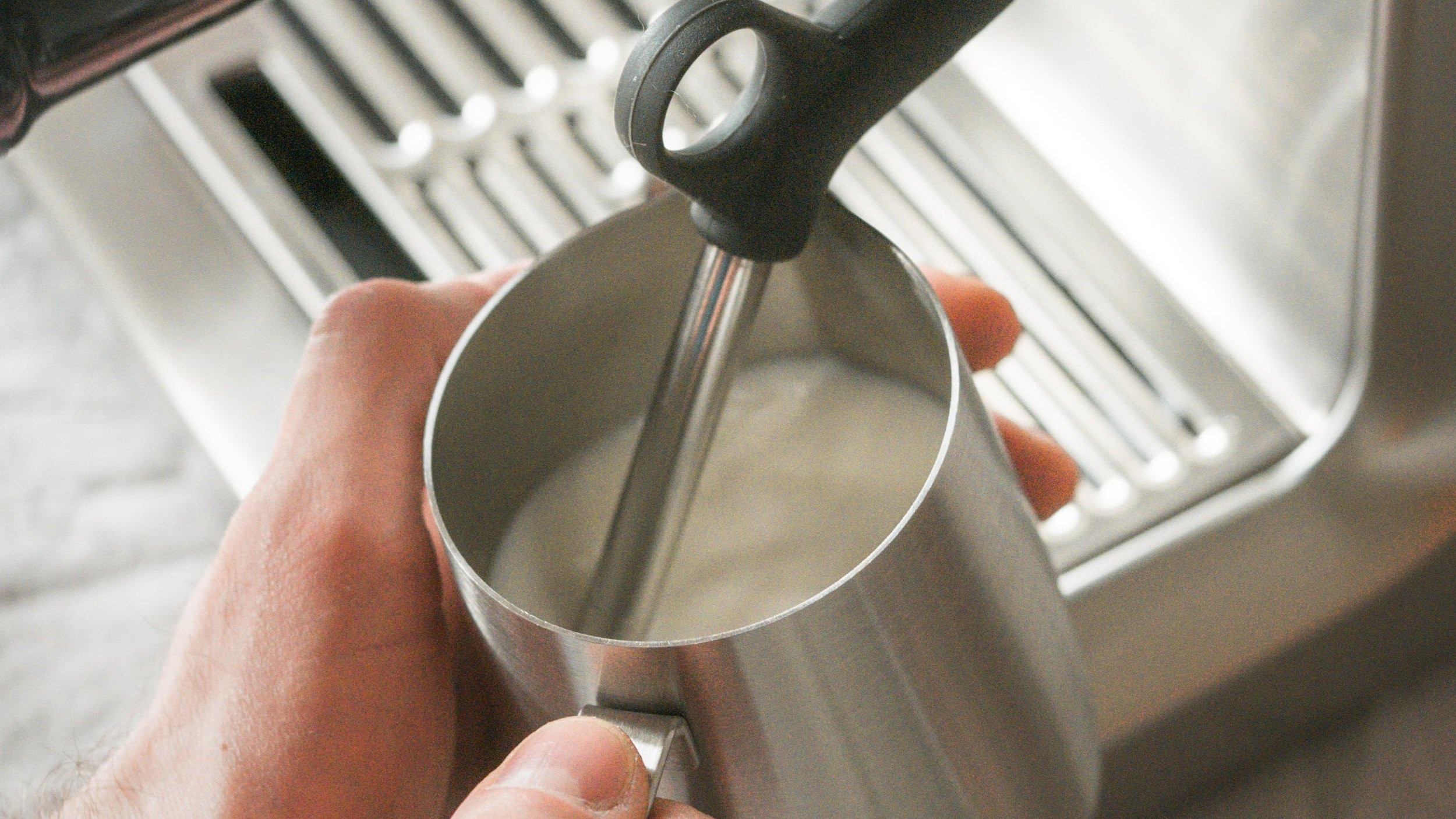Steaming milk with the Breville Barista Express opens up endless possibilities for creating barista-level beverages in the comfort of your own home. Whether you’re perfecting lattes, cappuccinos, or macchiatos, understanding how to achieve smooth, velvety microfoam is crucial to enhancing your coffee experience. This guide will walk you through the steps of steaming milk on the Breville Barista Express, addressing common challenges and offering expert tips to ensure your milk steaming is flawless every time. Discover the advanced features and performance of this machine in our Breville Dual Boiler BES920XL review
The Role of Steamed Milk in Perfect Coffee Creations
Steamed milk is an essential element in many coffee-based drinks. It not only adds a creamy texture but also plays a key role in balancing the boldness of espresso. The velvety microfoam, formed by introducing air into the milk, enhances the flavors and creates a perfect blend with the espresso, offering a rich, smooth experience. Learning how to steam milk properly can elevate your home coffee to professional-quality standards, making your coffee creations more enjoyable and rewarding. Learn about the ease of use and innovation in our Breville Barista Touch Impress review
Setting Up Your Breville Barista Express for Milk Steaming
Before you start steaming milk, ensuring your Breville Barista Express is properly prepared will set you up for success. Follow these steps to ensure optimal performance from your machine and steam wand. Compare these two popular models in our Breville Barista Express Impress vs Pro review
Preheat Your Breville Barista Express
To achieve the best results when steaming milk, your Breville Barista Express should be fully heated. After turning on the machine, wait for the steam indicator to light up, then allow an additional minute or two for the machine to reach the optimal steaming temperature. This extra time will ensure the steam wand performs at its highest efficiency, making the steaming process smoother. Find out which machine suits you better in our Breville Barista Pro vs Express review

Purge the Steam Wand
One of the key steps to getting the perfect foam is purging the steam wand. Turn the steam dial for a few seconds to release any water that may have accumulated in the wand. This is important because any residual water can dilute the milk and affect the texture of your foam, leading to poor results. Explore the key differences between these premium machines in our Breville Oracle vs Oracle Touch review
Essential Tools for Steaming Milk on the Breville Barista Express
For effective milk steaming, you’ll need the right tools at hand. Here’s a list of the essentials:
- Cold Milk: While whole milk is the best option for achieving a creamy texture, barista-grade oat or almond milk are great alternatives for those avoiding dairy.
- Stainless Steel Milk Pitcher: A stainless steel pitcher helps maintain the milk’s temperature and allows for better control while swirling the milk to create smooth microfoam.
- Thermometer (Optional): Although experienced baristas often gauge milk temperature by feel, using a thermometer provides precision, ensuring the milk doesn’t overheat.
Step-by-Step Instructions for Steaming Milk with the Breville Barista Express
The process of steaming milk with the Breville Barista Express is straightforward, but it requires attention to detail. Follow these steps for perfectly frothed milk:
1. Prepare the Milk
Pour cold milk into your stainless steel pitcher, filling it about one-third full. Starting with cold milk gives you more time to create the right texture before the milk heats up, allowing better control throughout the process.
2. Position the Steam Wand Correctly
Place the steam wand into the milk at a 15-20 degree angle, ensuring the tip is just beneath the surface of the milk. This position is crucial for creating the swirling motion needed to break down large bubbles and blend the foam smoothly into the milk.
3. Start the Stretching Phase
Turn on the steam and listen for a gentle hissing sound. Keep the steam wand close to the milk’s surface for about 5-10 seconds. This phase is known as “stretching,” where air is incorporated into the milk to create foam. Don’t overdo this stage, as too much air will lead to large, undesirable bubbles.
4. Texture the Milk
Once the stretching phase is complete, lower the pitcher slightly so that the wand is deeper in the milk. You should see the milk swirling in a whirlpool pattern, which helps to blend the foam and milk into a silky texture. This is the key to getting a smooth microfoam.
5. Achieve the Perfect Temperature
Aim for a milk temperature of about 150°F (65°C). If you’re not using a thermometer, feel the pitcher. When it becomes too hot to hold comfortably for more than a few seconds, stop steaming.
6. Finalizing the Steam Wand and Cleanup
Once you’ve reached the ideal temperature, turn off the steam and remove the wand from the milk. Clean the steam wand immediately by wiping it with a damp cloth to remove any milk residue. Then, purge the wand briefly to ensure there’s no milk left inside, which could clog the wand.
Perfecting Your Pour: Creating Beautiful Coffee Creations
Pouring is an art in itself. Here’s how to perfect your milk pour:
Start by pouring slowly with the pitcher close to the surface of the espresso. As you near the top of the cup, raise the pitcher slightly and increase your pouring speed to allow the foam to layer on top. With practice, you can even create latte art like hearts or rosettas, making your coffee look as great as it tastes.
Troubleshooting Common Milk Steaming Problems
Steaming milk can sometimes present challenges. Below are common issues and how to solve them:
1. Milk Not Frothing Properly
If your milk isn’t frothing, check the temperature of the milk, the positioning of the steam wand, and ensure that you are using cold milk. Also, remember to purge the steam wand to avoid water dilution.
2. Large Bubbles in Foam
Large, unsightly bubbles occur when too much air is incorporated. To fix this, adjust the steam wand so that it remains just below the milk’s surface. Avoid inserting the wand too deeply into the pitcher to prevent excessive air.
3. Overheating Milk
Overheated milk loses its sweetness and may even taste burnt. To avoid this, monitor the milk temperature carefully. If you don’t have a thermometer, stop steaming when the pitcher becomes too hot to touch for more than a few seconds.

Conclusion: Achieving Barista-Level Milk Steaming with Your Breville Barista Express
Mastering milk steaming on the Breville Barista Express is a skill that improves with practice and patience. By following the steps outlined in this guide and troubleshooting any challenges you encounter, you can create the smooth, velvety microfoam needed for perfect lattes, cappuccinos, and other coffee drinks. Whether you are refining your steaming technique or practicing latte art, the key is to enjoy the process. With consistency and the right approach, you’ll soon be making café-quality coffee drinks in your own kitchen.
Frequently Asked Questions About Steaming Milk
What Type of Milk is Best for Steaming?Whole milk is the ideal choice for creating rich, creamy foam. However, barista-grade oat or almond milk is a fantastic dairy-free alternative that froths well and provides a similar texture to dairy milk.
Why Isn’t My Milk Frothing?Ensure that you’re using cold milk and positioning the steam wand just below the milk’s surface. Additionally, always purge the steam wand before steaming to improve frothing.
How Can I Prevent Overheating My Milk?Using a thermometer will help prevent overheating. If you don't have one, stop steaming when the pitcher becomes too hot to hold comfortably for more than a few seconds.
Can I Use Non-Dairy Milk?Yes, barista-grade non-dairy milks such as oat or almond milk are designed to froth well and work seamlessly with the Breville Barista Express, providing a creamy texture similar to dairy milk.
